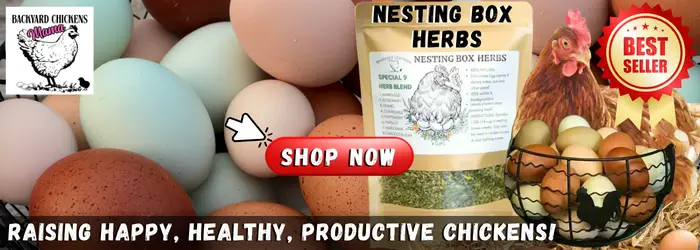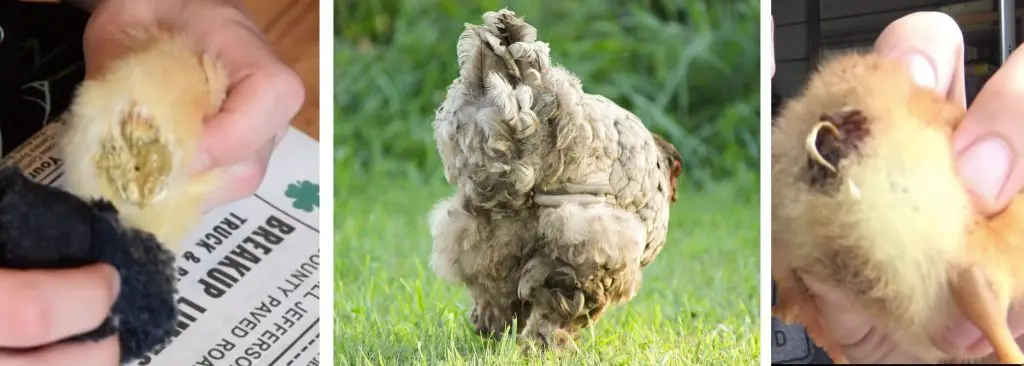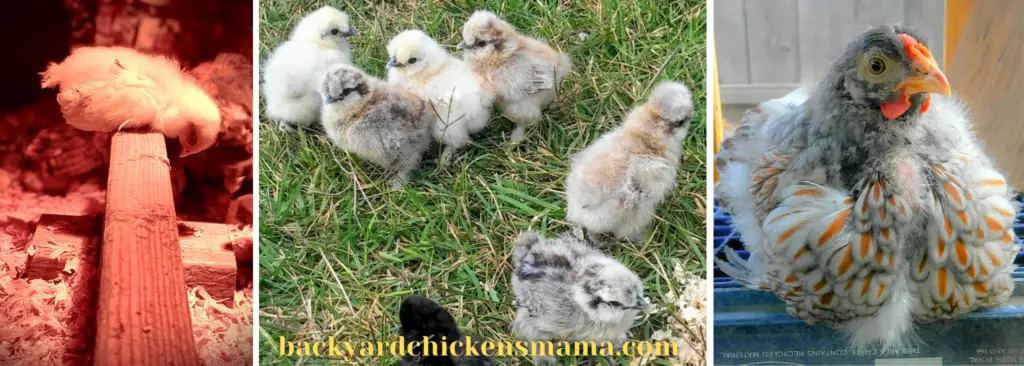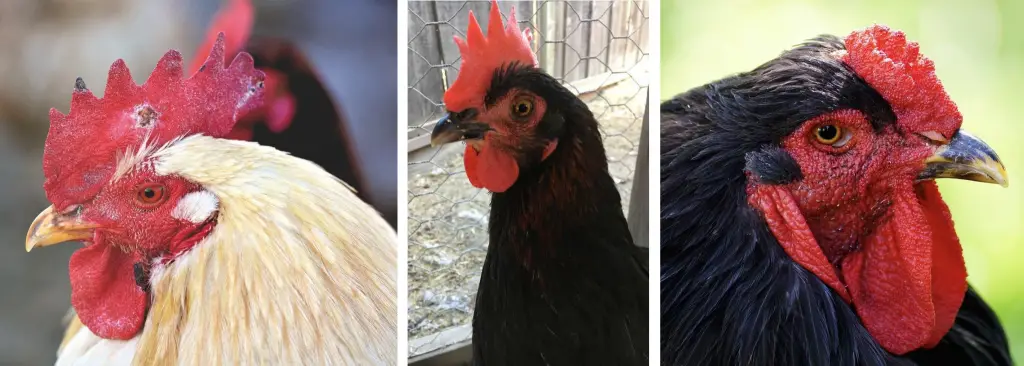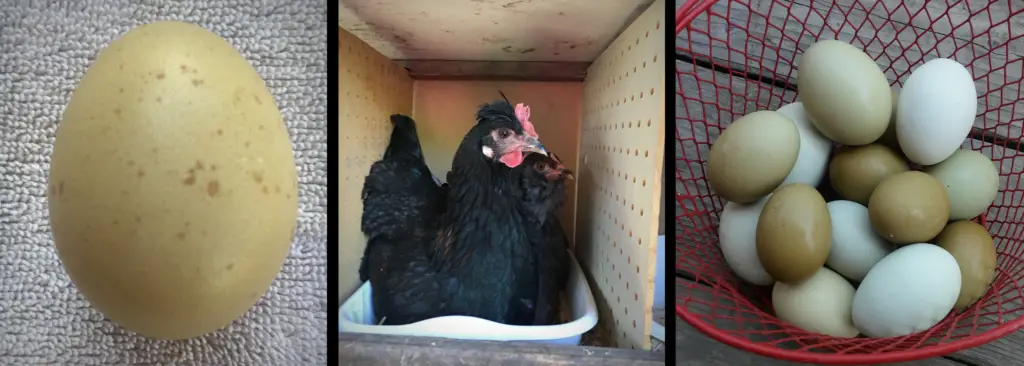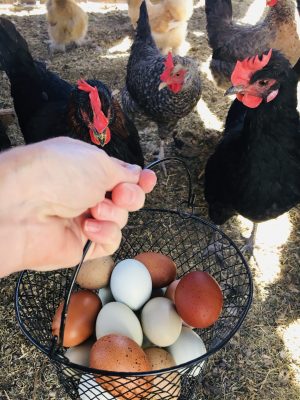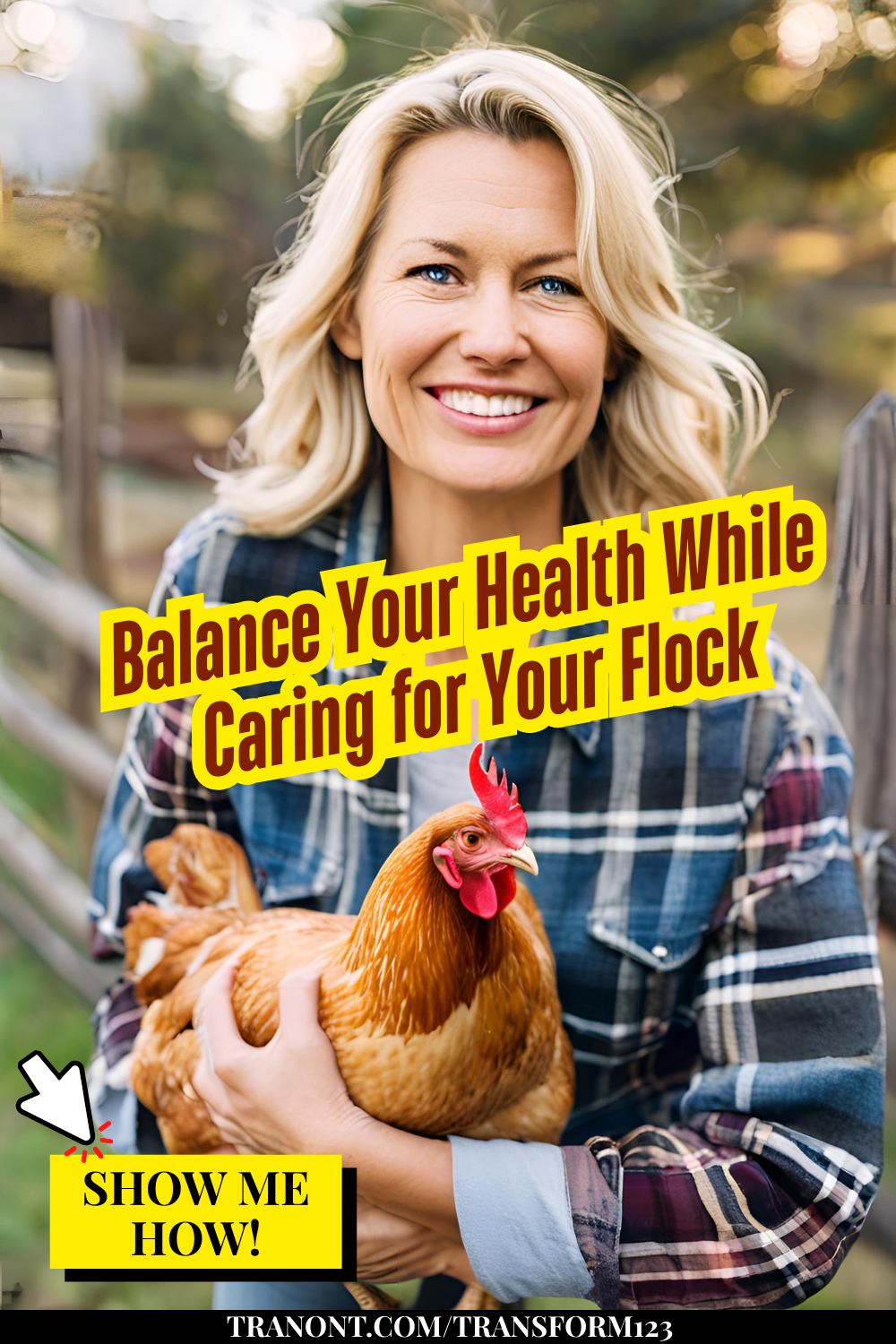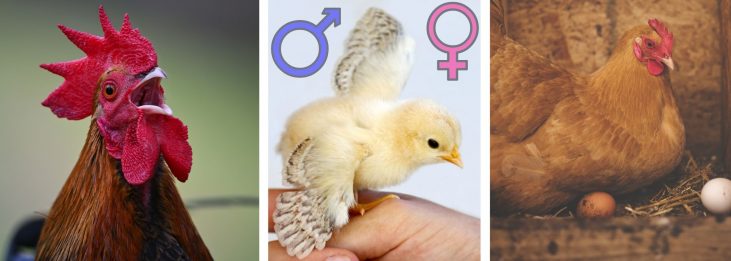
Do you know how to tell a rooster from a hen? With most chicks, you can tell if you have a cockerel or a pullet as young as 1 day old. Chickens possess both physical features and behavioral signs that, if you are aware of, can help you to determine if you have a male or a female.
As a chicken reaches maturity, this will become even more evident.
One of the most common questions I hear by people that own chickens is, “Is this a rooster or a hen?” While no method is 100% accurate, the more physical and behavioral signs that point to you having a rooster or a hen, the more likely you are to get it right.
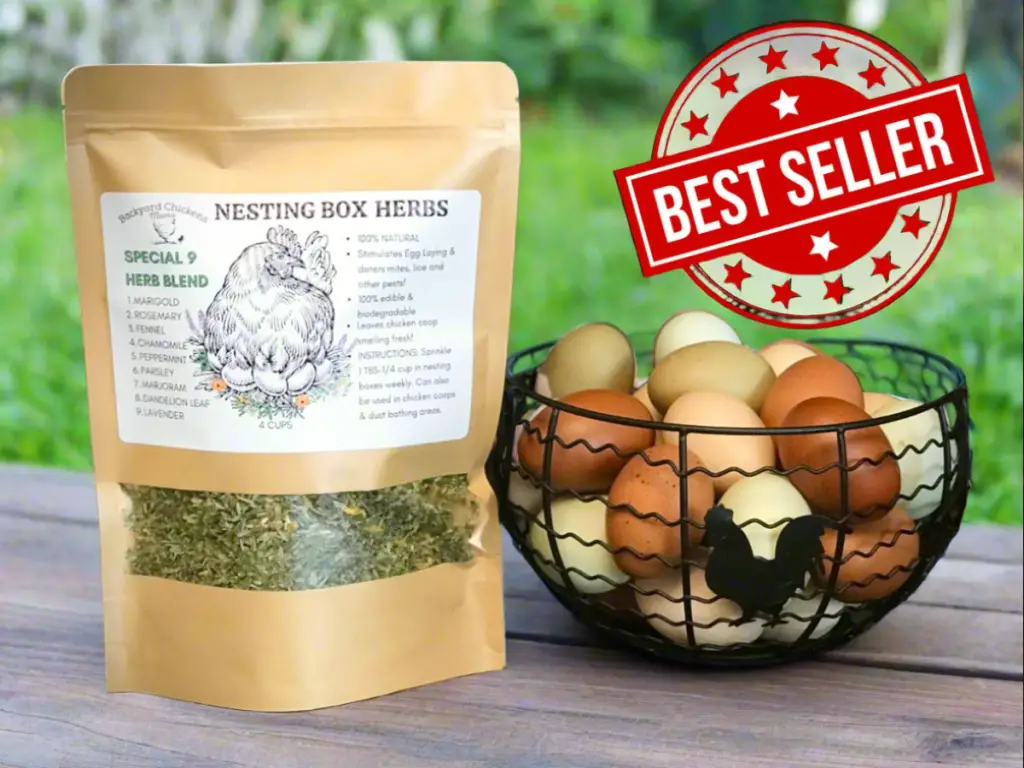
Increases egg laying naturally.
- Improves chicken health.
- Deters parasites: mites, lice, fleas & flies as well as mice, rats, raccoons, coyotes, opossums and more!
- On SALE!
- Shop: Nesting Box Herbs
Reasons for Needing to Know if You have Roosters or Hens
- Depending upon where you live, you may not be able to keep roosters.
- Too many roosters can cause fighting. It is important to only keep 1 rooster for every 7-10 hens.
- Too many roosters can cause overmating of the hens. This can result in a loss of feathers on the hens back. If a hen goes into winter with a big loss of feathers, it is possible for her to die from hypothermia.
- Loss of feathers on a hens back can also lead to sunburn.
- With loss of feathers, a roosters spurs are likely to puncture the skin on the back of a hen during mating, which can lead to an infection.
Chicken Terminology
- Rooster = Male Adult Chicken (over 1 year)
- Hen = Female Adult Chicken (over 1 year)
- Cockerel = Young Rooster (under 1 year)
- Pullet = Young Hen (under 1 year)
- Chicken = Rooster, Hen, Cockerel and Pullet
10 Best Tips-How to Tell a Rooster from a Hen
| HOW TO TELL A ROOSTER FROM A HEN |
|---|
| 1. VENT CHECK |
| 2. WING FEATHER SEXING |
| 3. TEMPERAMENT |
| 4. COMB & WATTLE |
| 5. HACKLE, SADDLE & SICKLE FEATHERS |
| 6. SPURS |
| 7. AUTOSEXING OR SEX-LINKED |
| 8. TIDBITTING |
| 9. CROWS |
| 10. LAYS EGGS |
#1. Vent Sexing a Baby Chick
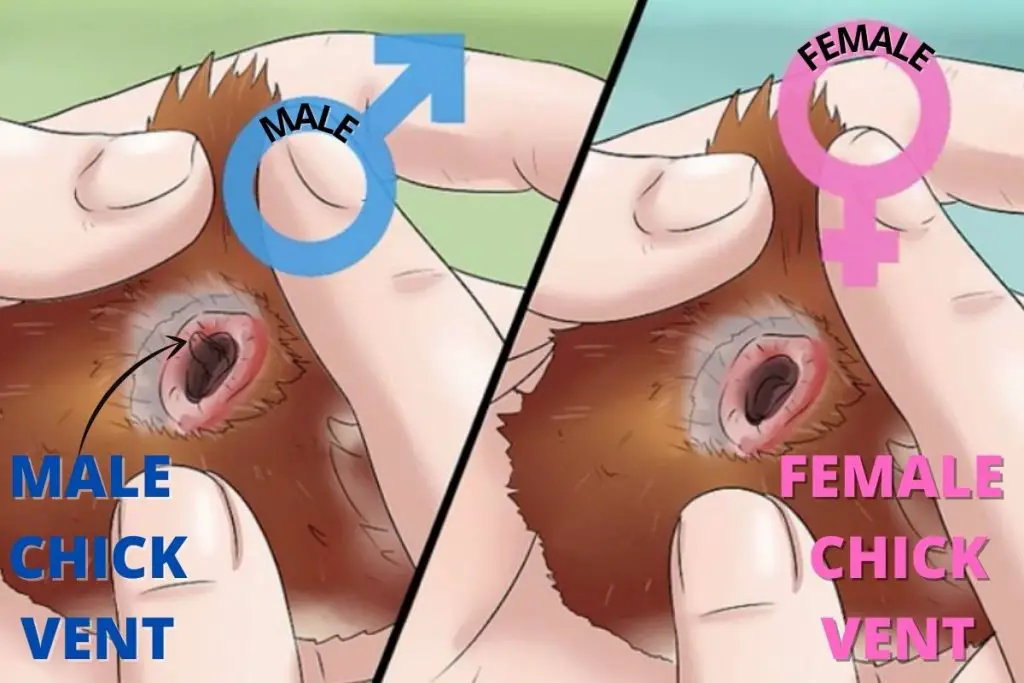
Where is the Vent on a Baby Chick?
A vent is the same orifice that a chick defecates from. This is the same hole that a hen will lay eggs from. It is located at the backend of a chick, just below the tail feathers or fluff.
Is Vent Checking Accurate?
If vent checking is done by experts, it is said to be about 95% accurate. Even experts can get it wrong sometimes! A novice person, the accuracy is a little lower, at about 75% accuracy or 3 out of 4 chicks being correct.
In some breeds, the “bump” indicating the chick is a male is not as prominent, making it more difficult to tell, especially for a novice.
The Silkie breed develops much slower, so you are unable to determine if a Silkie is male or female with a vent check.
IMPORTANT TIP: Vent checking must be done on one day old baby chicks. Any older than this and it is much more difficult to see the prominent “bump.” This is because the chicks digestive system distends downward after eating, covering it up.
How to Vent Check a Baby Chick
- Baby chicks can chill quickly, so make sure you have warmed hands before performing this test.
- Gently hold a one day old baby chick in your non-dominant hand.
- Lightly hold its head between your pointer and middle finger.
- At the same time, lightly hold its feet between your ring and pinky fingers.
- Using your dominant hand, gently pull up the tail “fluff,” exposing the vent. It isn’t uncommon for the chick to poop when you do this, so you may want to do this over a sink or paper towel. It’s good if they do poop, because it makes it easier to see inside the vent. If it doesn’t pass any feces, apply a little bit of pressure to its abdomen for it to excrete any poop that may be in the anal vent.
- Using your dominant hand fingers, very gently move the fluff away from the lining of the vent. If it is a male chick, you will see a tiny little prominence or bump. Female chicks do not have this.
#2. Wing Feather Sexing in Baby Chicks-Cockerel vs. Pullet
Wing feather sexing is another way that you can use to tell if a chick is a cockerel(male) or a pullet(female). Male and female chicks feather out at different rates.
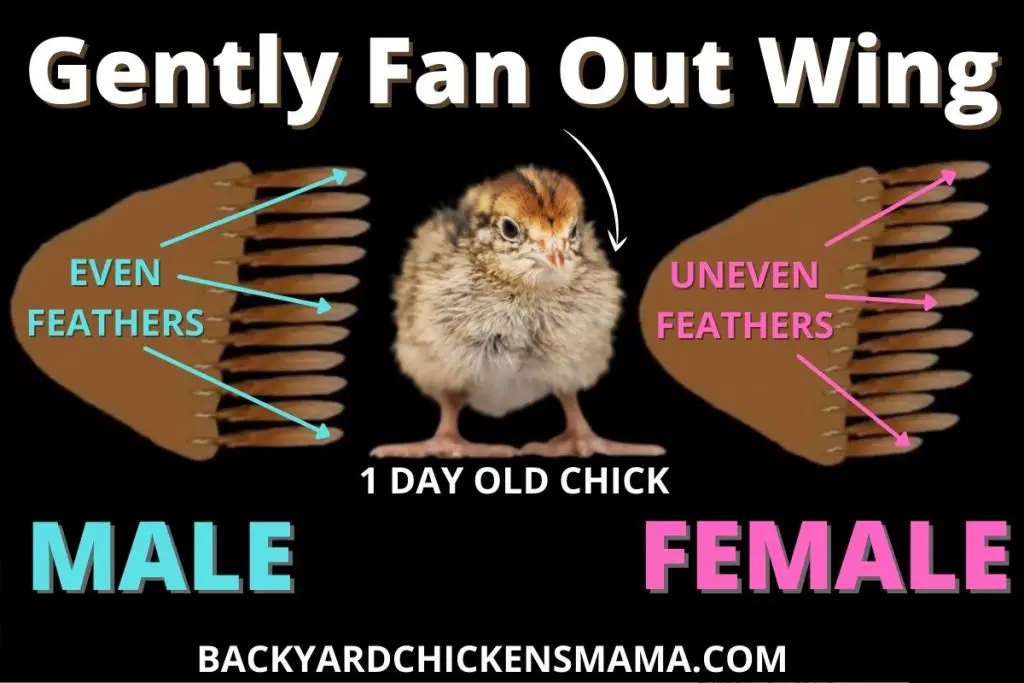
How Can You Tell if a Baby Chick is Male or Female by Wing Feathers?
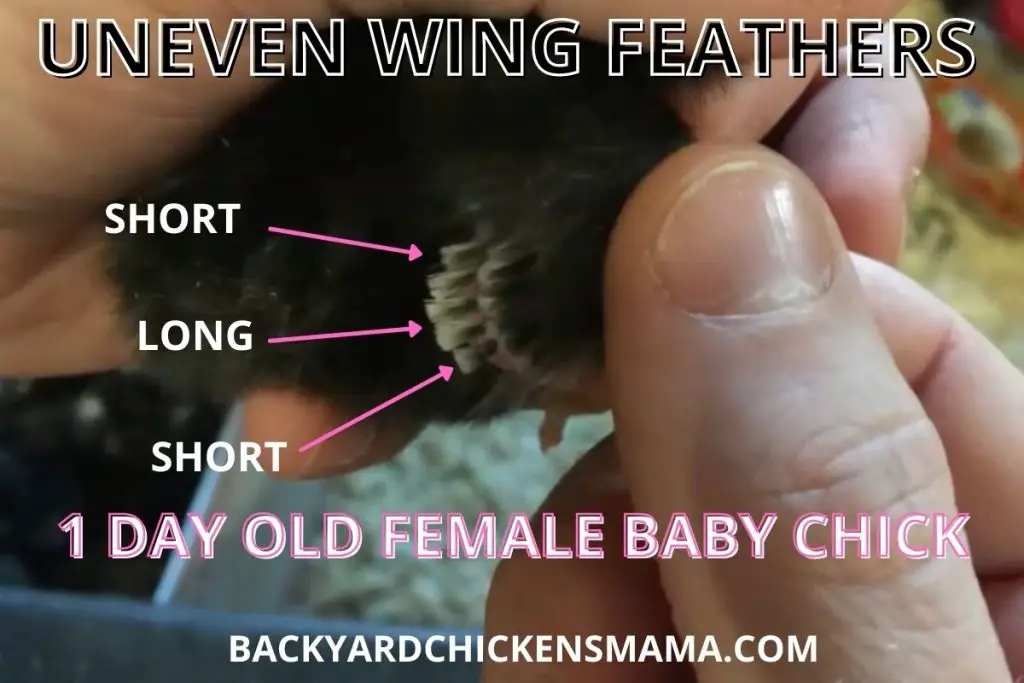
Female chicks or pullets, feather out sooner than male chicks or cockerels do. The wing feathers are the first feathers for baby chicks to grow. Many female chicks begin to develop their first wing feathers before they even hatch.
How to Check Wing Feathers to Determine Sex of Baby Chick (First 48 Hours)
- Wing sexing must be done within the first 48 hours of a chick hatching for the best accuracy.
- Warm your hands first. Baby chicks can chill quickly.
- While securely holding your baby chick in your hand, very gently fan out its wing feathers with the opposite hand. Take special care not to bend the feathers or pull out too far.
- Male wing feathers are all equal in length whereas female chicks are unequal (see diagram above).
Can All Chicks be Sexed by Wing Feathers?
Not all breeds can be feather sexed. Some breeds, such as slow growing dual purpose breeds, are more difficult to use this method and this may not be as accurate.
#3. Temperament Differences-Hens vs. Roosters
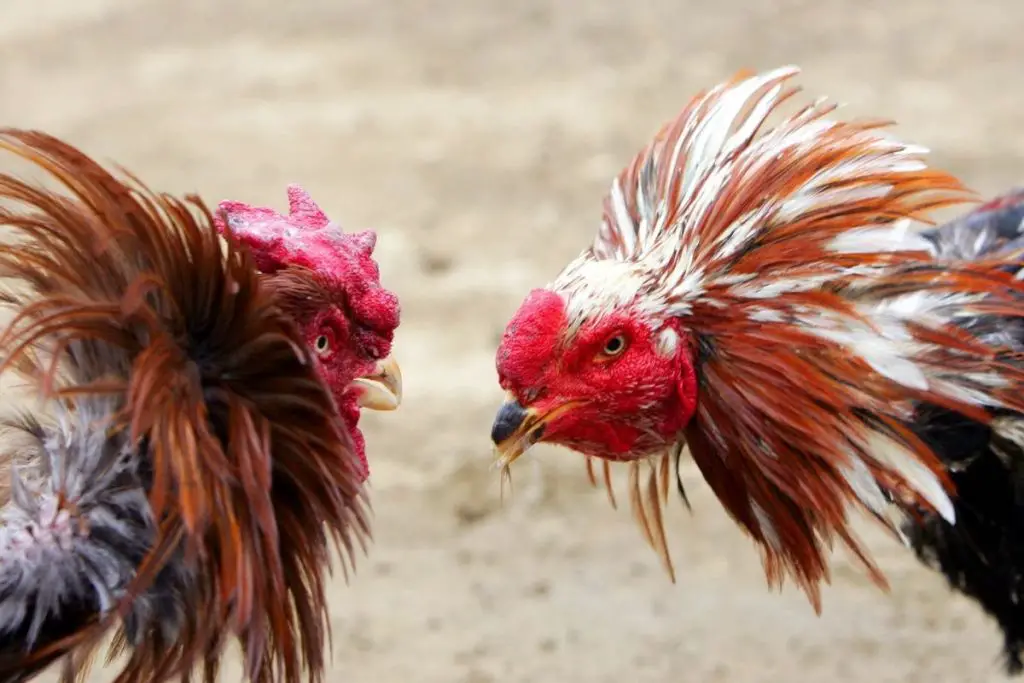
Do All Rooster Become Aggressive?
Compared with hens, it is more common for roosters to become aggressive. But this does not mean that all roosters are aggressive. There are some roosters that are extremely friendly and enjoy being held.
Roosters reach their peak testosterone levels when they go through puberty around 6-8 months of age. This is when they seem to be the most aggressive or when a once loving rooster gets more aggressive.
Just remember, a big part of a roosters job is to protect its flock and this requires it to get aggressive in order to keep his ladies safe from harm.
The important thing is to make sure it doesn’t get aggressive with you. Many times flock owners will go into the chicken run with a rake or broom to wave at a rooster. You want to let your rooster know that YOU are above him in the pecking order.
Behavior Differences in Roosters and Hens
- Male chicks tend to stand up taller, more upright, than female chicks.
- Both male and female chicks will chest bump, but when they get a little bit older and do this, a males long, pointed hackle feathers will stand up and be much more noticeable.
- Increased aggressiveness can be an indicator of a rooster, especially if paired with several other physical or behavioral signs.
#4. Comb and Wattle Differences in Roosters and Hens
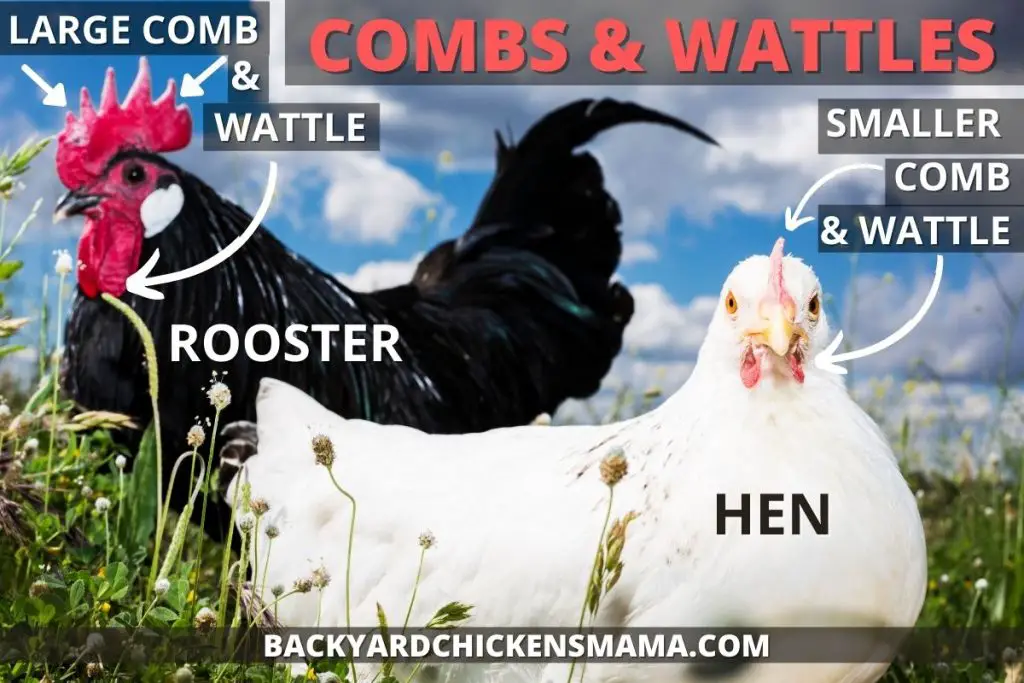
Do Hens Have Combs Like Roosters?
- Compared to hens, most breeds of roosters have larger combs and wattles.
- Young cockerels begin to develop little combs and wattles as young as 5-6 weeks.
- A fully mature rooster will have a larger and a deeper red comb and wattle than a fully mature hen.
Why are Rooster Combs and Wattles so Big and Red?
- Roosters use their large combs and wattles to attract hens.
- So h ens can easier identify a potential mate.
- Roosters use their large combs and wattles to help cool them down during hot weather.
#5. Hackle, Saddle and Sickle Feathers-Hens vs. Roosters
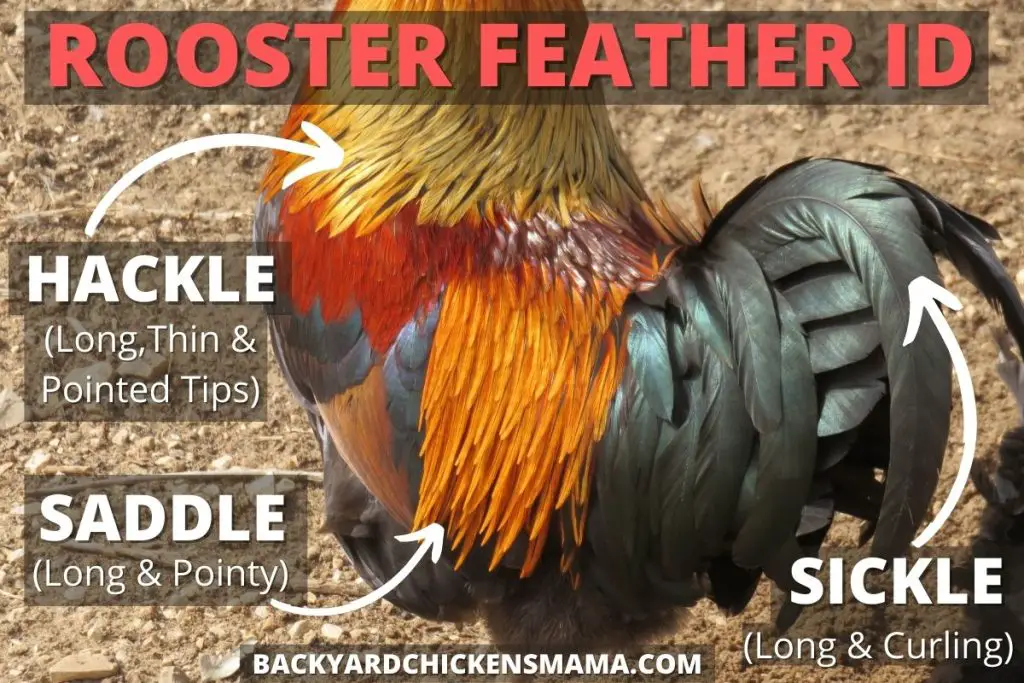
What are Hackle Feathers?
Hackle feathers are the feathers around a chickens neck. Both roosters and hen have hackle feathers, but they look very different. A hens hackle feathers are shorter and rounded at the end whereas a roosters hackle feathers are longer, pointier and also much prettier or “showy.”
At around 3 months of age you can begin to tell the difference between a cockerel and pullets hackle feathers. This is when you will start to notice that the tips of the males are longer and have a pointed tip and the pullets are shorter with a rounded tip.
What are Saddle Feathers?
Saddle feathers on a chicken are located in front of the tail. Both roosters and hens have saddle feathers, but they look very different. A hens saddle feathers are shorter and rounded at the end whereas a roosters saddle feathers are longer, pointier and more colorful.
Around 3 months of age you can begin to notice a difference in the cockerel and pullet saddle feathers. Males begin to grow longer, pointier and sometimes colorful saddle feathers around this time.
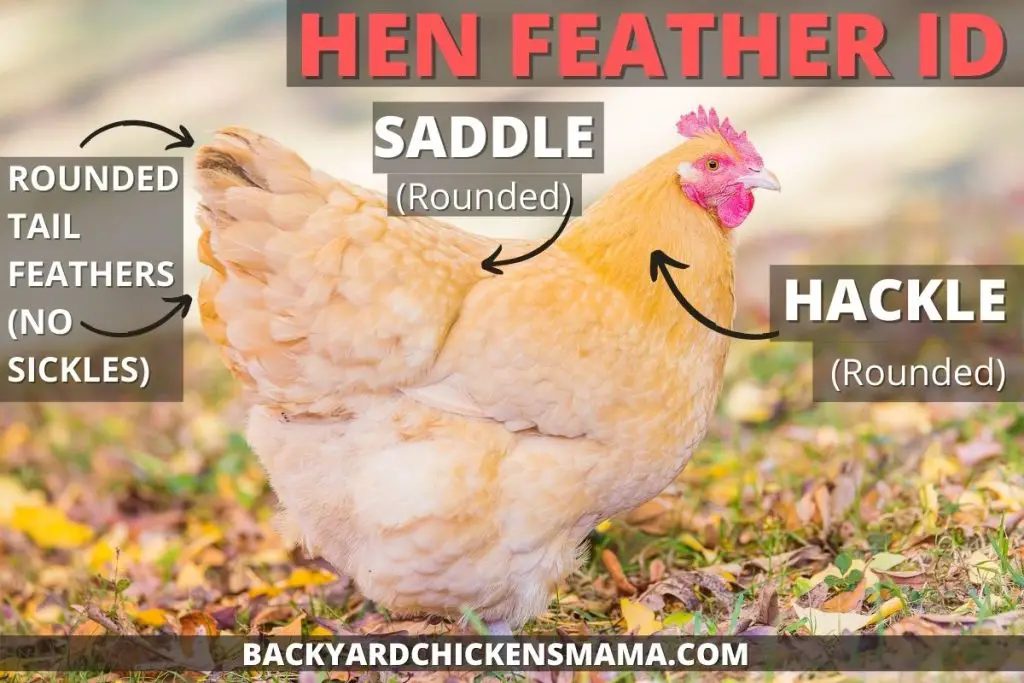
What are Sickle Feathers?
Sickle feathers are the long, curved and pointy feathers coming out of the sides of a roosters tail feathers. Sickle feathers get better looking as the rooster ages. Cockerels begin to develop sickle feathers around 4-6 months old.
Hens do not have sickle feathers. Instead, they have short, rounded tail feathers.
| HACKLES (3 MONTHS) | SADDLES (3 MONTHS) | SICKLES (4-6 MONTHS) |
|---|---|---|
| COCKERELS: LONG, POINTED, SHOWY | COCKERELS: LONG, POINTED, SHOWY | COCKERELS: LONG, CURVED, POINTED |
| PULLETS: SHORTER, ROUNDED | PULLETS: SHORTER, ROUNDED | PULLETS DO NOT HAVE SICKLES |
#6. Spurs-Hens vs. Roosters
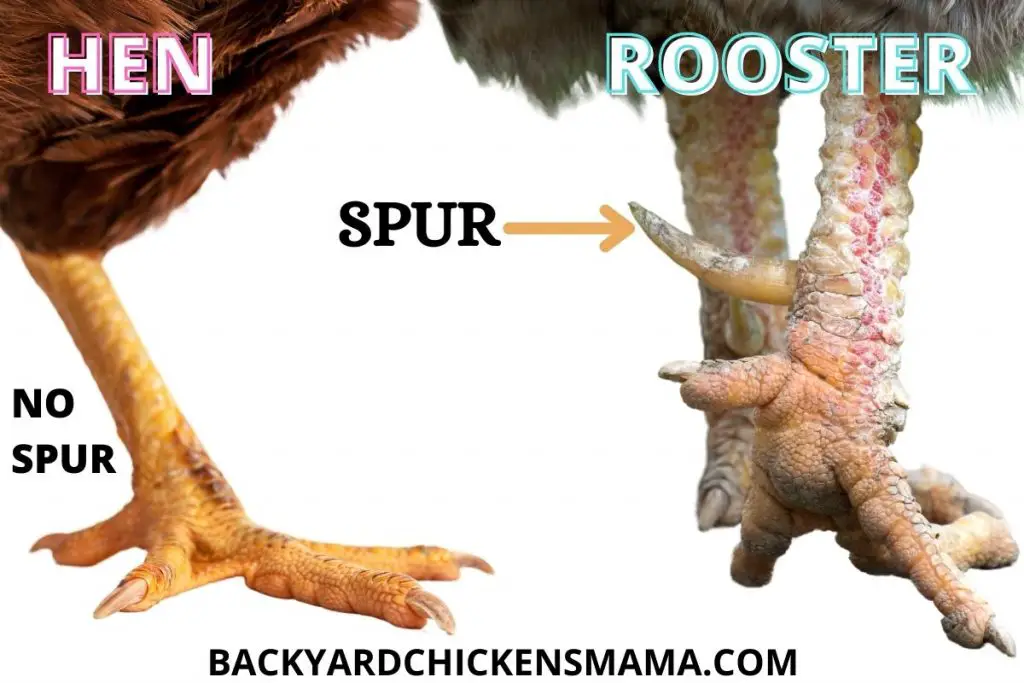
What are Spurs on a Chicken?
Spurs are hard claw like growths coming off the shank of a chickens leg. It looks like it could be a 5th toe. Roosters are known to develop hard, sharp spurs. A rooster uses its sharp spurs to protect both himself and his flock of hens from predators.
Spurs sometimes continue to grow, curling until they pierce into the chickens leg. Keep an eye on your chickens spurs and trim them if the get too long.
Be careful. If a rooster sees you as a threat, they will not hesitate to use them on you too!
Do Roosters and Hens Have Spurs?
Most hens do not develop spurs, but it is possible for them to. Hens that do develop spurs are usually older and the spurs are much smaller in size.
#7. Autosexed and Sex-linked Chickens
Autosexed: Some chicks hatch with certain colorings or markings in their downy fluff that let you know what sex they are.
Sex-linked: Hybrid varieties of chickens where males and females hatch out a different down color, making it easy to identify if they are male or female.
Example of Autosexing Chicken Breed
| CRESTED CREAM LEGBAR FEMALE CHICK PATTERNS | CRESTED CREAM LEGBAR MALE CHICK PATTERNS |
|---|---|
| DARKER BROWN | LIGHTER BROWN |
| CHIPMUNK PATTERN DOWN BACK | NO CHIPMUNK PATTERN |
| CHIPMUNK PATTERN AROUND EYES | WHITE SPOT ON TOP OF HEAD |
Sex-linked Chickens
| BREED | MALE | FEMALE |
|---|---|---|
| GOLDEN COMET (RED SEX-LINKED) | PALE YELLOW | GOLDEN BUFF WITH STRIPES |
| BLACK STAR (BLACK SEX-LINKED) | ALL BLACK WITH WHITE STAR ON TOP OF HEAD | ALL BLACK |
| ISA BROWN (RED SEX-LINKED) | WHITE | REDDISH |
#8. Roosters will Dance to Attract Hens (Tidbitting)
What is “Tidbitting” and Why do Roosters Do It?
Both roosters and hens will make a high pitched clucking noise when they find some good food and want to share it. A hen will do this with her young chicks and a rooster will do this when he finds some food that he wants to share with his hens.
A rooster will try to impress his hens by finding food and bringing it to a desired mate. He will place the food in front of them, pick it up and drop it, bob his head side to side, swinging his large, bright red comb and wattle. This so called dance is called tidbitting.
#9. Roosters Crow
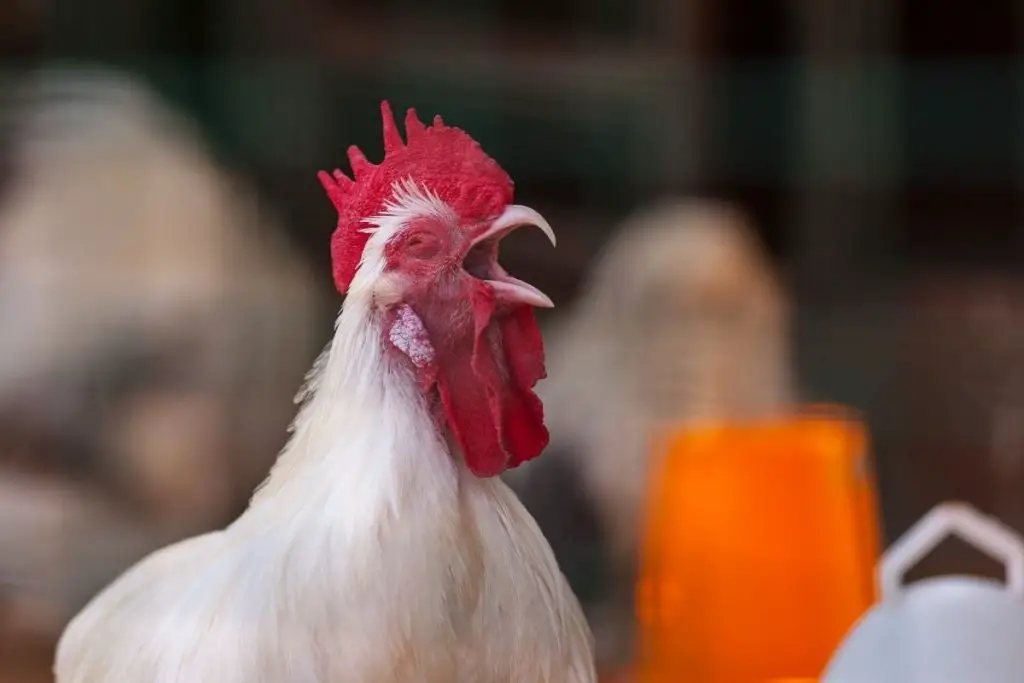
Why Do Roosters Crow?
| WHY DO ROOSTERS CROW? |
|---|
| IN ANTICIPATION OF DAWN |
| ARTIFICIAL LIGHTING IN COOP MAKING A ROOSTER THINK DAWN IS COMING |
| TO WARD OF PREDATORS |
| TO WARN HIS HENS A PREDATOR IS NEAR |
| PERSONALITY/ BECAUSE THEY ARE JUST A MORE VOCAL ROOSTER |
Why is My Hen Crowing?
Sometimes, especially when there is not a rooster in the flock, a hen will take the place as the most dominant “rooster.” She may even make vocalizations similar to a rooster crowing.
#10. Hens Lay Eggs
One of the most obvious signs that you have a hen is when she starts laying eggs. When this happens, this is a 100% indicator that your chicken is female!
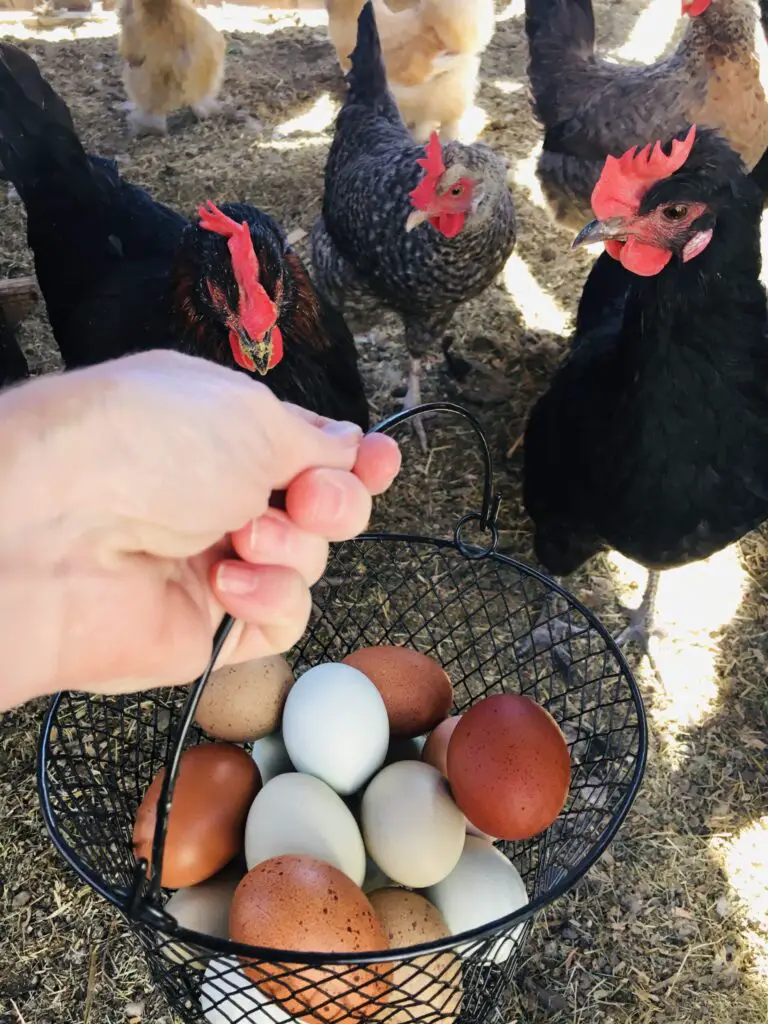
When do Chickens Start Laying Eggs?
Most hens will begin to lay eggs around 16-24 weeks of age. Some breeds, such as Silkies, this can be much later. There are usually signs that your hen is approaching laying age.
When a hen reaches sexual maturity, she will have increased blood flow into her comb and wattle. This is what gives it a deeper red appearance.
During this time she is also more agreeable to mating with a rooster. If a rooster is not part of the flock, she may squat down when you approach her. This is called the “submissive squat.”
If you feel her pelvic bones, you will notice that as she approaches laying age, they will separate. This is to allow an egg to pass through.
A hen that is about ready to lay will also frequently visit the nesting boxes to familiarize herself with them. This is why it is good to either open the nesting boxes or have them available at around 16 weeks.
During her visits to the nesting box, you may notice that she is much more vocal than usual. This is normal. She knows that she is about ready to lay and she wants to let everyone in the flock know.
| SIGNS A HEN IS APPROACHING LAYING AGE |
|---|
| COMB AND WATTLES BECOME LARGER AND ARE DEEP RED |
| “SUBMISSIVE SQUAT”- HEN WILL SQUAT WHEN YOU APPROACH HER |
| HEN IS FULL GROWN |
| PELVIC BONES SEPARATE |
| HEN FREQUENTLY VISITS THE NESTING BOX |
| HEN BECOMES MORE VOCAL |
Can Hens Lay Eggs Without a Rooster?
Hens most certainly can lay eggs without a rooster. A hen is capable of producing one egg every 26 hours. Without a rooster, her eggs are infertile and not capable of producing a baby chick.
If you do have a rooster and he mated with a hen, her eggs will be fertile and capable of producing chicks. They must be sat on or incubated for 21 days to produce a chick.
If you have a broody hen that likes to sit on fertile eggs, it is important to gather them daily if you do not want chicks. This way they do not start to develop.
It is perfectly fine to eat a fertilized egg. Both fertilized and unfertilized eggs taste the same.
Do Male Chickens Lay Eggs?
Male chickens do not and will not lay eggs. Some roosters will visit a nesting box and sit on a hens eggs, but this is rare.
CONCLUSION: 10 Best Tips-How to Tell a Rooster from a Hen
The anticipation of knowing if your new chicks are male or female is great, but sometimes the little chicks will keep you guessing until they reach sexual maturity and either start crowing or lay an egg.
Egg laying is the most obvious sign that you have a hen and is 100% accurate.
Crowing is almost always a sign that you have a rooster. It isn’t common, but some hens will belt out a “cock a doodle do!” This is more seen in a flock without a rooster. Some hens will become the dominant “rooster” and try to crow.
Overall, the more physical and behavioral signs you have that point to having either a rooster or a hen, the better the chances are that this is accurate.
| HOW TO TELL A ROOSTER FROM A HEN |
|---|
| 1. VENT CHECK |
| 2. WING FEATHER SEXING |
| 3. TEMPERAMENT |
| 4. COMB & WATTLE |
| 5. HACKLE, SADDLE & SICKLE FEATHERS |
| 6. SPURS |
| 7. AUTOSEXING OR SEX-LINKED |
| 8. TIDBITTING |
| 9. CROWS |
| 10. LAYS EGGS |
10 Best Tips-How to Tell the Difference Between a Rooster and a Hen– https://www.backyardchickensmama.com/how-to-tell-a-rooster-from-a-hen/
